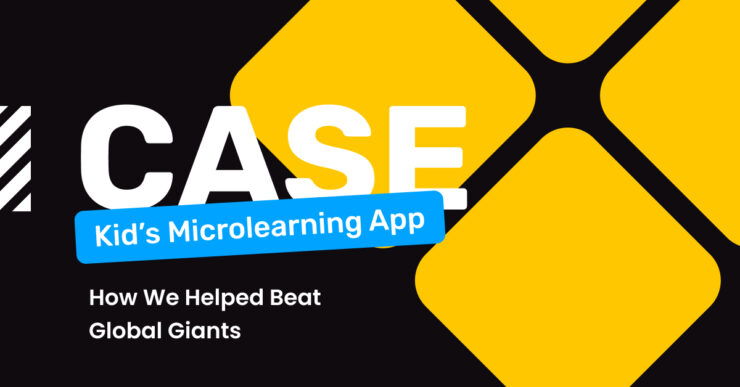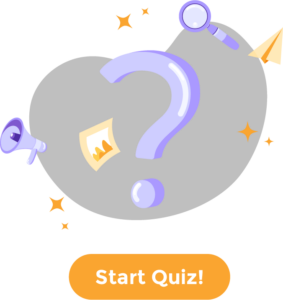How a kids’ microlearning app achieved top rankings against Duolingo, ABC, and Lingokids through strategic keyword promotion.
- Overview:
- The Challenge of Education App Competition
- Strategic Keyword Selection for Educational Apps
- The 5-Day Campaign Structure
- High-Frequency Keyword Campaigns
- Mid-Frequency Keyword Campaigns
- Low-Frequency Keyword Campaigns
- Results and Algorithm Insights
- Best Practices for Education Category Apps
- Conclusion
Breaking into the education app category represents one of the most formidable challenges in mobile app marketing. Dominated by well-funded global brands like Duolingo, Khan Academy, ABC Kids, and Lingokids with massive user bases and years of market presence, the category leaves little room for newcomers to gain visibility through organic means alone. Yet this case study demonstrates how strategic keyword promotion can level the playing field, enabling a focused microlearning app to compete effectively against industry giants.
This real-world example showcases how a kids’ microlearning app targeting parents worldwide achieved significant ranking improvements across multiple keyword tiers in just days. With over ten years of experience in keyword promotion, Keyapp has developed specialized strategies for highly competitive categories like education, where traditional ASO approaches often fall short against established competitors with substantial brand recognition.
The Challenge of Education App Competition
The education app category stands as one of the most saturated and competitive spaces in both the AppStore and Google Play. According to market research, the global English learning apps for kids market continues its rapid expansion, driven by increasing smartphone penetration, growing demand for digital learning solutions, and the accelerated shift toward remote education. This growth attracts both established institutions and innovative startups, intensifying competition across all educational subcategories.
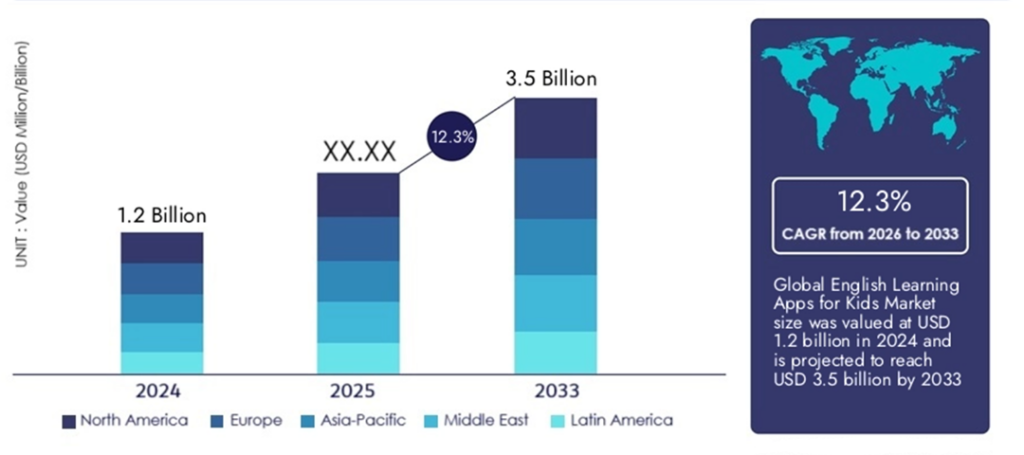
Source
The parental decision-making process adds another layer of complexity. Unlike casual app downloads, educational app selection involves careful consideration – parents research extensively, read reviews, compare features, and often trial multiple apps before committing. They use highly specific search terms like “phonics games for preschool” or “alphabet practice app,” indicating clear intent but also creating numerous keyword opportunities. However, rankings matter critically: parents rarely scroll beyond the first page of results, making top-five positions essential for visibility.
The microlearning app featured in this case study arrived with several advantages but faced the typical visibility challenges of the education category.
Strengths:
- Strong retention rates indicating effective content and user experience
- Positive user reviews from existing users demonstrating satisfaction
- Innovative microlearning approach aligned with current educational research
- Content designed specifically for parent-child co-learning
Challenges:
- Limited brand recognition outside existing user base
- Rankings outside top fifty for most relevant keywords
- Competing against apps with millions of downloads and thousands of reviews
- Basic ASO implementation insufficient to drive discoverability
Traditional ASO optimization had achieved modest improvements in metadata and conversion rates, but organic growth remained limited by poor search visibility. To break through, the app needed dramatic ranking improvements across strategically selected keywords that parents actively used when searching for educational content.
Strategic Keyword Selection for Promotion
Successful keyword strategy in the education category requires balancing search volume, competition intensity, and user intent. Our approach structured keywords across three tiers, each serving specific objectives in establishing market presence against global competitors like Duolingo and Lingokids.
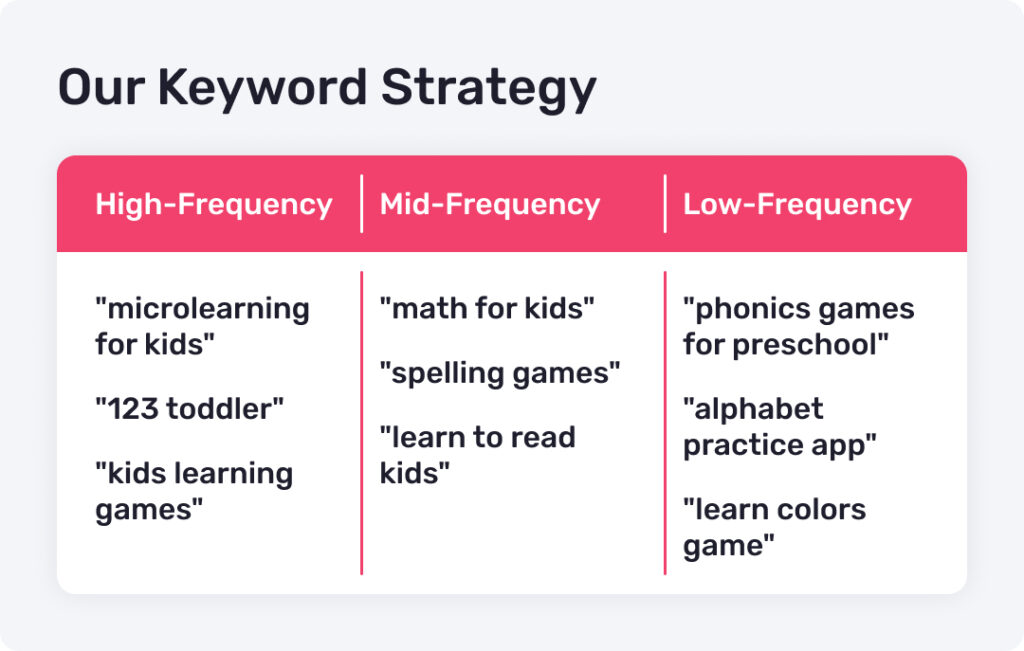
We selected nine keywords total, distributed strategically: three high-frequency keywords for maximum visibility (“microlearning for kids,” “123 toddler,” “kids learning games”), three mid-frequency keywords for targeted traffic (“math for kids,” “spelling games,” “learn to read kids”), and three long-tail keywords for high-intent users (“phonics games for preschool,” “alphabet practice app,” “learn colors game”).
High-frequency keywords would establish brand presence despite intense competition, mid-frequency terms offered the optimal balance of achievable rankings and meaningful traffic, while long-tail keywords provided early successes that built algorithmic confidence across related keywords.
The 5-Day Campaign Structure
Our five-day campaign structure balanced strong positioning with natural mobile growth patterns that avoid triggering algorithms. This approach has proven effective across numerous education category apps, delivering sustainable ranking improvements through carefully selected daily install volumes.
High-Frequency Keyword Campaigns
For our three high-frequency keywords (“microlearning for kids,” “123 toddler,” “kids learning games”), we implemented our most active promotional campaign:
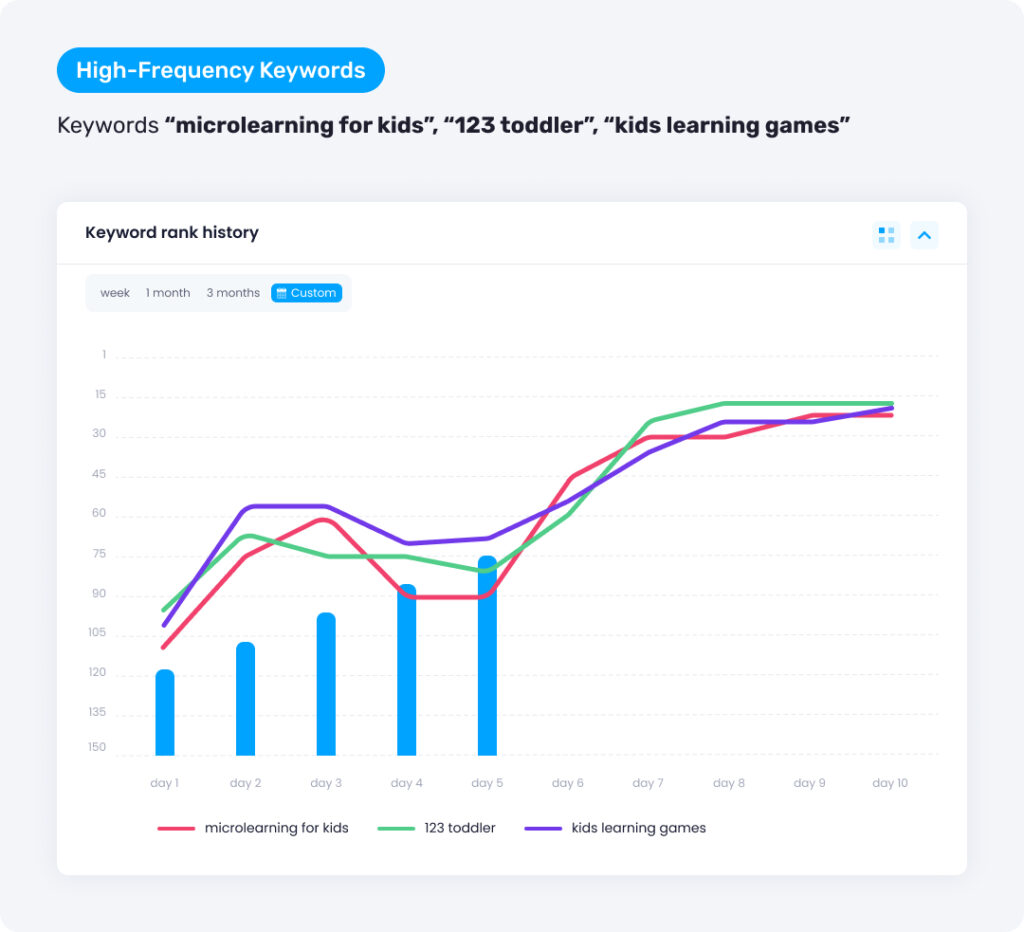
Day 1: 75-100 installs. The initial day establishes baseline algorithmic signals. Seventy-five to one hundred installs represents substantial volume but remains within ranges that could occur organically for an app gaining momentum through word-of-mouth or social sharing. This conservative start allows us to gauge algorithm response before scaling.
Day 2: 100-125 installs. With initial signals established, day two increases volume by approximately 25-30%. This acceleration mirrors natural growth patterns when an app begins gaining traction.
Day 3: 125-150 installs. Day three continues the progressive increase, pushing toward our peak volumes. At this stage, we typically observe initial ranking movements as the algorithm begins recognizing the app’s relevance for target keywords. These early improvements, even if modest, validate our strategy and approach.
Day 4-5: 150-175 installs. The final two days maintain peak volumes rather than continuing aggressive scaling. This plateau demonstrates sustained interest rather than a temporary spike, which the algorithm values.
Mid-Frequency Keyword Campaigns
Mid-frequency keywords (“math for kids,” “spelling games,” “learn to read kids”) required proportionally scaled volumes while following the same progressive pattern:
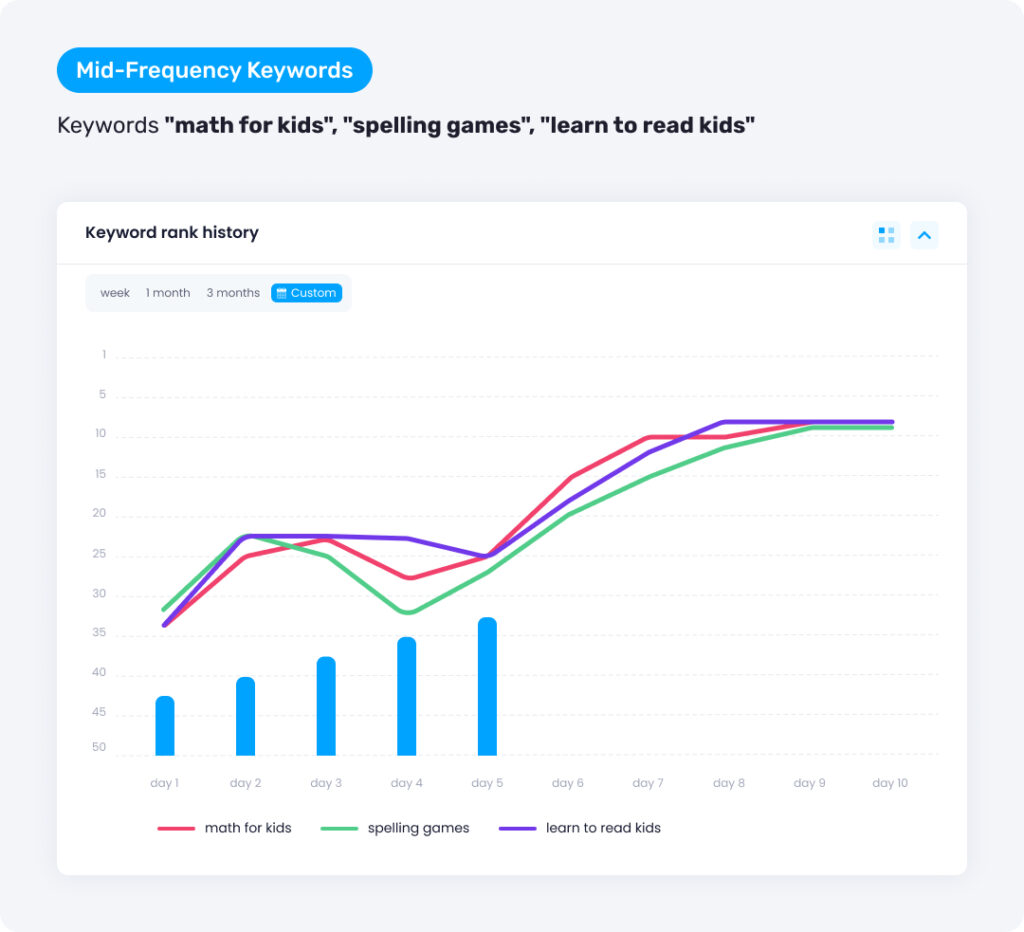
Day 1: 50-75 installs. Starting volumes for mid-frequency terms run approximately 60-70% of high-frequency campaigns.
Day 2: 65-90 installs. Progressive increase maintains natural growth appearance while building momentum.
Day 3: 80-115 installs. Approaching peak volumes, we typically observe stronger ranking movements for mid-frequency terms by this stage compared to high-frequency keywords.
Day 4-5: 105-130 installs. Peak maintenance at these levels proved sufficient to secure top ten positions for mid-frequency terms in most cases.
Low-Frequency Keyword Campaigns
Low Frequency, long-tail, keywords (“phonics games for preschool,” “alphabet practice app,” “learn colors game”) required the most modest volumes but delivered exceptional return on investment:
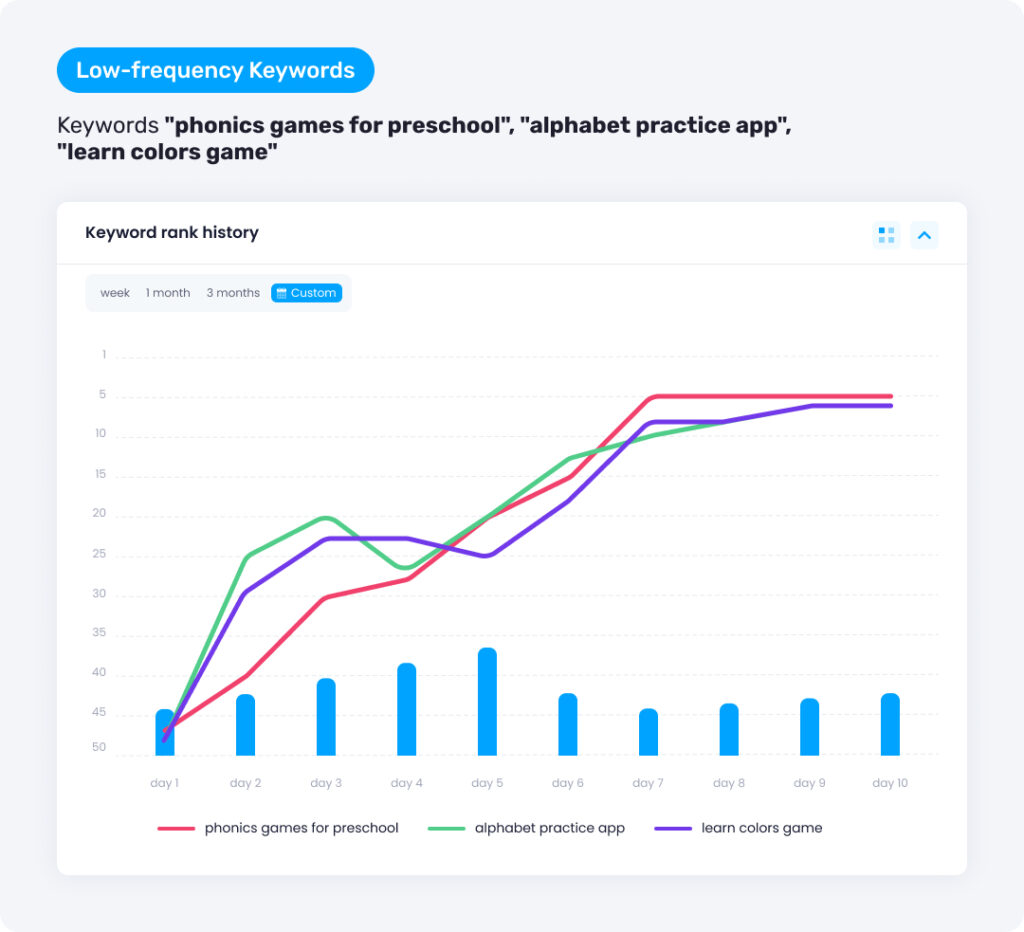
Day 1: 20-25 installs. Even small daily volumes create meaningful signals for keywords with lower competition and search volume.
Day 2: 30-35 installs. Progressive increase maintains a natural growth pattern while building algorithmic momentum.
Day 3: 40-45 installs. Approaching peak volumes, we typically observe first ranking movements into top ten positions for long-tail terms.
Day 4-5: 50-55 installs. Peak maintenance at these modest levels consistently delivers top five positions for long-tail keywords.
Results and Algorithm Insights
The five-day campaign delivered exceptional results across all keyword groups, with particularly strong performance in mid-frequency and long-tail categories. More importantly, the campaign revealed valuable patterns about how educational apps can compete effectively against established players through strategic positioning.
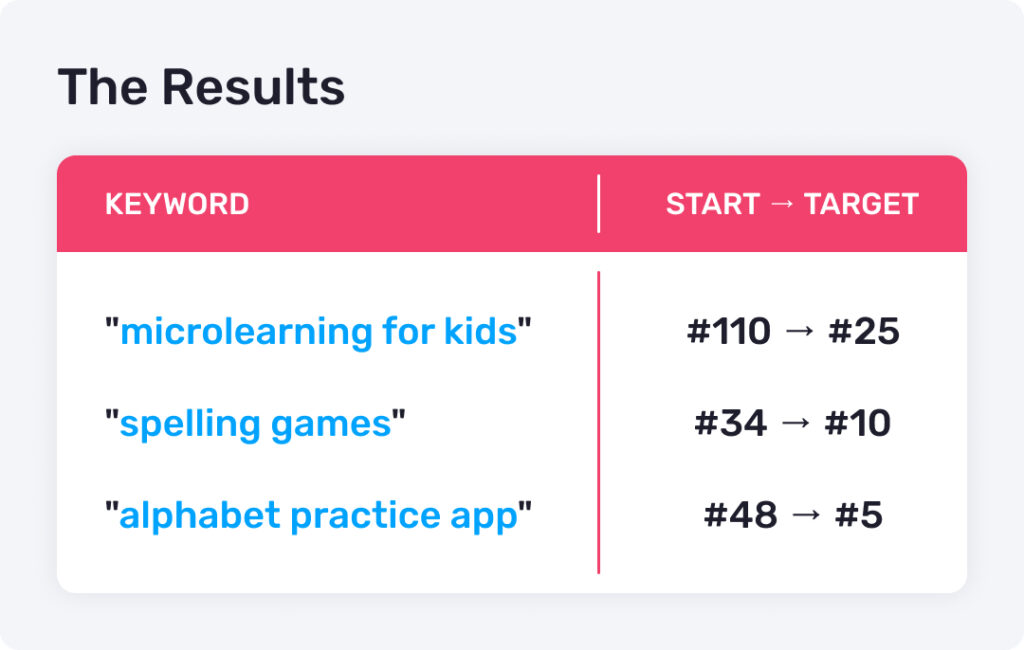
High-Frequency Keywords showed solid improvements: “microlearning for kids” jumped from position 110 to 25, “123 toddler” moved from 67 to 18, and “kids learning games” climbed from 89 to 22. While not reaching top five, these positions delivered 15-20% of search traffic – a dramatic improvement from near-zero visibility outside top fifty.
Mid-Frequency Keywords proved most cost-effective: “math for kids” advanced from 52 to 12, “spelling games” achieved position 7 from 34, and “learn to read kids” reached 14 from 43. These rankings generated immediate traffic increases and established subject-area credibility.
Long-Tail Keywords dominated their categories: “phonics games for preschool” secured position 3, “alphabet practice app” reached position 5, and “learn colors game” claimed position 4. Despite lower search volumes, these keywords delivered 30-35% conversion rates compared to 15-20% for broader terms.
The most significant finding involved cross-keyword influence. Success with “spelling games” positively affected rankings for related keywords like “learn to read kids” and “alphabet practice app,” even without direct promotion. This semantic clustering effect meant the algorithm recognized our app’s broader educational relevance, improving positions across unpromoted keywords.
Best Practices for Education Category Apps
The education app category presents unique challenges and opportunities that require specialized approaches beyond general ASO principles. Drawing from this campaign and our broader experience with educational apps, several best practices emerge for achieving and maintaining competitive rankings in this demanding space.
1. Invest in Fundamentals First
No promotional campaign compensates for poor reviews, insufficient content, or mediocre user experience. Build a quality product with demonstrated educational value before investing in ranking improvements.
2. Ensure Trust & Compliance
Implement essential features expected by parents, such as COPPA-compliant parental controls and progress tracking. Strive for an ad-free experience to maintain trust and professional credibility.
3. Strategize Keyword Clustering
Parents make educational app decisions differently than users choosing games or productivity tools. Keywords, messaging, and positioning must reflect the concerns and decision criteria of your actual audience. Prioritize age-specific keywords (e.g., “toddler games,” “preschool learning,” “kindergarten math”) that parents actively search for. Focus on building subject area clusters (e.g., dominate “reading,” “phonics,” “alphabet”) before expanding into unrelated topics. This reinforces algorithmic subject expertise.
4. Time Campaigns for Peak Demand
Schedule promotional campaigns strategically around periods of high user intent:
- Late August / Early September (Back-to-School)
- January (New Year’s Resolutions/Learning Goals)
- Summer Months (Educational Entertainment)
5. Accelerate Post-Install Reviews
Actively request user feedback immediately after a positive learning experience or goal completion, never during moments of user frustration.
6. Strategic Patience Delivers Results
Breaking into top positions against established giants requires sustained effort across multiple keyword tiers and potentially multiple campaign cycles. However, the long-term value of improved organic visibility justifies the investment.
Conclusion
This case study demonstrates that educational apps, despite facing intense competition from well-funded global brands, can achieve meaningful market presence through strategic keyword promotion. The keys to success involve understanding parental search behavior, selecting keyword portfolios that balance visibility with achievable rankings, and implementing promotional campaigns that mirror organic growth patterns.
At Keyapp, we’ve successfully promoted numerous educational apps across diverse subject areas, age ranges, and market positions. Our methodology combines deep understanding of category-specific algorithm behavior with proven promotional strategies that achieve sustainable ranking improvements.
Ready to compete with the giants in education? Contact Keyapp’s expert team to develop a customized keyword promotion strategy that establishes your app as a top choice for parents seeking quality learning tools.

